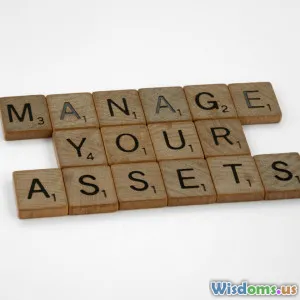
Should You Hold Cash During Capital Markets Volatility
10 min read Explore whether holding cash is a wise strategy during capital markets volatility and learn how to balance cash allocations with market opportunities. (0 Reviews)
Should You Hold Cash During Capital Markets Volatility?
Capital markets are known for their cyclical nature and episodic bouts of volatility. When markets swing sharply—whether due to geopolitical tensions, economic uncertainty, or unexpected shocks—many investors reconsider their investment strategies, notably the decision to hold cash.
Holding cash might seem like a refuge in turbulent times, but is it really the safest harbor? Or does parking money in cash during volatile markets mean missing out on valuable growth opportunities? This article takes a deep dive into the strategic role of cash holdings during periods of capital markets volatility, backed by historical data, expert opinions, and real-world examples.
Understanding Capital Markets Volatility
Volatility refers to the frequency and magnitude of price fluctuations in financial markets. It’s often measured by indicators like the VIX (Volatility Index), dubbed the "fear gauge." Elevated volatility typically suggests increased risk or uncertainty among market participants.
Historically, significant markets shifts have been accompanied by sudden spikes in volatility—for example, during the 2008 financial crisis, the COVID-19 pandemic onset in early 2020, and geopolitical events like the Russia-Ukraine war. Each of these episodes brought heightened uncertainty, prompting reconsideration of asset allocations.
Why Volatility Matters for Investors
Volatility affects portfolios in multiple ways:
- Risk of loss: Larger, abrupt price swings can erode portfolio value swiftly.
- Opportunity: Drops in asset prices during volatile phases can create buying opportunities for disciplined investors.
- Psychological impact: High volatility can induce fear or poor decision-making, leading to suboptimal outcomes.
The question then arises: Should investors raise cash buffers to mitigate these risks?
Advantages of Holding Cash During Volatile Periods
1. Liquidity and Flexibility
Cash provides liquidity—immediate access to funds without the need to sell assets at depressed prices. This is invaluable during market downturns when selling investments might realize losses.
For example, during the March 2020 market crash prompted by the pandemic, investors with dry powder (cash reserves) rapidly seized discounted stocks, such as in the technology sector, which recovered robustly over the subsequent months.
2. Capital Preservation
Cash can act as a safe haven. Unlike stocks or bonds, cash does not expose investors to market risk. In highly uncertain times, this preserves capital and mitigates downside risk—particularly crucial for conservative investors or those near retirement.
3. Emotional Comfort and Reduced Stress
The peace of mind that comes with knowing some of your holdings are liquid and lower risk can prevent panic selling and emotional investing.
4. Opportunity to Buy During Dips
Market volatility often presents bargains. Holding cash allows investors to deploy capital strategically when prices are attractive, enhancing long-term returns.
The Drawbacks of Holding Excessive Cash
1. Inflation Erosion
One of the main downsides of holding cash is that in a low-interest-rate environment, inflation can erode purchasing power. For instance, if a savings account pays 1% interest while inflation runs at 4%, the real value of cash diminishes over time.
2. Opportunity Cost
Prolonged holding of cash means missed dividends, capital gains, and compounding returns that equities or fixed income may provide. Historically, stocks have earned an average annual return of around 7-10%, significantly outperforming cash.
3. Market Timing Risk
Attempting to time market corrections to buy assets at the perfect bottom rarely succeeds. Investors holding onto cash might miss rapid rebounds and thereby reduce overall portfolio growth.
4. Lower Overall Portfolio Growth
Excessive cash allocation can drag down portfolio performance, especially in prolonged bull markets following volatile phases.
Historical Insights: Cash Allocation During Volatility
Between 2000 and 2020, the MSCI World Index experienced multiple bearish periods where high volatility forced reevaluation of asset positioning:
- Dotcom bust (2000–2002): Many investors who remained heavily invested experienced significant losses; those holding cash preserved capital but had limited opportunities to re-enter quickly.
- 2008 Global Financial Crisis: Investors with cash on hand took advantage of discounted assets post-crash, leading to significant gains in the subsequent recovery.
- COVID-19 Crash (2020): Quick market rebound rewarded investors who capitalized on volatility with available cash reserves.
According to a Schwab study, investors with a cash buffer ranging from 5-15% were better positioned to weather volatility without missing growth opportunities.
Strategic Approaches to Holding Cash
1. Dynamic Cash Allocation
Instead of a fixed cash percentage, some sophisticated investors adjust cash levels based on market conditions, volatility indicators, and valuation metrics. For example, increasing cash moderately when volatility spikes and reallocating as markets stabilize.
2. Emergency Fund vs. Investment Cash
Distinguish between cash held for emergency needs (3-6 months of expenses) and tactical cash set aside for opportunities. This clarity prevents panic selling in volatile markets.
3. Diversified Portfolio Incorporation
Cash should complement a diversified portfolio including equities, bonds, and alternatives. Balancing cash with income-generating and growth assets optimizes risk-adjusted returns.
4. Alternatives to Holding Pure Cash
Consider liquid, low-risk instruments such as money market funds or short-term Treasury bills, which yield modest returns with minimal volatility.
Expert Opinions
Investment legend Warren Buffett famously advised, "Be fearful when others are greedy and greedy when others are fearful," emphasizing the opportunity value of cash and liquidity during market downturns. He also maintained a substantial cash reserve during volatile periods, enabling decisive investments at opportune times.
Famed economist Mohamed El-Erian highlights the psychological advantages of holding cash, helping investors avoid costly emotional reactions.
However, some experts caution that holding too much cash can be a drag over the long term and suggest balancing cash holdings with disciplined rebalancing strategies.
Practical Tips for Investors
- Assess your risk tolerance: More conservative investors may benefit from higher cash holdings.
- Define your investment horizon: Cash makes sense for short-term needs but can impair growth in the long run.
- Monitor market indicators: Use volatility measures to inform tactical cash allocation.
- Set re-entry rules: Establish predetermined conditions or price targets before investing cash.
- Maintain discipline: Avoid emotional moves and stick to your financial plan.
Conclusion
Holding cash during capital markets volatility offers both protective benefits and the flexibility to seize opportunities. However, it is a double-edged sword—excess cash can erode wealth through inflation and missed returns.
A mindful approach involves maintaining sufficient liquidity to safeguard against unforeseen needs and market downturns, while keeping enough invested to benefit from long-term growth. Dynamic, personalized strategies, informed by data and professional insights, can help investors harness the best of both worlds.
Ultimately, the decision to hold cash should align with your overall financial goals, risk appetite, and market outlook. By understanding the trade-offs and employing disciplined tactics, investors can improve resilience and capitalize on volatility rather than be intimidated by it.
Remember: Capital markets volatility is not inherently a threat but rather a landscape of risks and opportunities. Cash is a tactical tool—its true value lies in how and when it's wielded.
#Investing #CapitalMarkets #Volatility #CashStrategy #PortfolioManagement
Rate the Post
User Reviews
Popular Posts




















